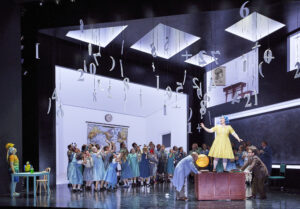
Opera Australia 2023 Review: The Tales of Hoffmann
By Gordon WilliamsPhoto credit: Keith Saunders
Opera Australia more than made-up for a recent spate of revivals with the world premiere at Sydney Opera House on July 11th of Damiano Michieletto’s production of Offenbach’s “Tales of Hoffman,” a co-production with Royal Opera House Covent Garden, Opéra National de Lyon, and Venice’s Teatro La Fenice.
Michieletto’s arresting production of Rossini’s “Il viaggio a Reims” was seen here in 2019 and might be considered by some as a little “out there.” It personified “Viaggo’s” multinational dramatis personae as famous artworks from the travelers’ homelands. How would “Hoffmann” compare?
The story was certainly made clear. Perhaps Offenbach’s setting of “Hoffmann” in 19th century Nuremberg was not so apparent in this staging but in other ways this production was faithful to Hoffmannesque story-telling in its evocation of the supernatural flavor of the German-Romantic stories by E.T.A. Hoffmann on which the opera is based. Magic tricks helped, but Hoffmann’s muse, performed by mezzo-soprano Sian Sharp, transformed not into Nicklausse a human friend, but Nicklausse a “talking parrot.” This is a ‘familiar’ perhaps if we are to continue the terminology of the spirit-world. She is trying to draw the soul of the central character, the poet Hoffmann, back from a series of fruitless loves, as seen in each Act, toward his art.
At this point, the part of Nicklausse was taken over by Iran-born mezzo-soprano Agnes Sarkis in parrot costume but also operating a parrot puppet that might at times lodge in another part of the stage from the source of Nicklausse’s voice.
As well, the production mapped Hoffmann’s progress through life as it followed him from schoolboy in a classroom to a tuxedo-clad sophisticate in Giulietta’s salon.
This production did not call for the combining of the Muse/Nicklausse parts that can sometimes occur. However, Australian soprano Jessica Pratt performed all four of Hoffmann’s loves including Olympia, Antonia, Giulietta and Stella in later Acts. This was a super-impressive achievement about which I will write more later.
Meanwhile, Sharp’s Muse took more of a presiding role, appearing before the curtain at the beginning of each Act, as if conjuring the proceedings. This symbolized Hoffmann’s recounting of his various unrequited loves. We thus had the opportunity to hear two fine mezzos, both Sharp and Sarkis, over the course of the evening.
“A Midsummer Night’s Dream” might have been one of this production’s reference points, especially considering the ballet corps of fairies in Act one and the large choreographic element in the production. This was altogether courtesy of Chiara Vecchi, a member of the excellent Italian production team. It also comprised Paolo Fantin (set designer), Carla Teti (costumes), Alessandro Carletti (lighting) and Eleonora Gravagnola (Associate Director).
Though the Muse and Nicklausse were not doubled on this occasion, indicating that the muse maintained her otherworldly identity, doubling can be an interesting feature of the opera.
Other significant “multi-tasking” included Australian tenor Adam Player making the most of each of the four Acts’ servants including Cochenille, Pitichinaccio, and an amusingly camp ballet master as Frantz. His deliberately robotic “ouis” and “nons” as Andres in Act one came across as if coerced via witchcraft.
Croation bass-baritone Marko Mimica was formidable as the four villains (Coppelius, Dapertutto, Dr Miracle and Lindor). He had a clear-focused presence that penetrated well out into the auditorium. It’s worth mentioning the effectiveness of one single device here in designer Carla Teti’s costume scheme – the villain’s black gloves. They spoke volumes.
The title character, Hoffmann, appears in all four stories. Peruvian tenor Iván Ayón Rivas brought convincing passion to the role. One of the effective highlights of Act one was his narrative of Kleinzach based on the Hoffmann short story, “Little Saches called cinnabar.” This was boisterous and fun but rivetingly hushed on its repeat.
“Hoffmann” is a work that almost showcases the chorus and the Opera Australia Chorus was one of this production’s lynchpins. The rollickingly effective drinking songs of Act one were a highlight. The men were particularly active and engaging in their stage business of moving around chairs.
And now to the doubling act that made the night. Australian soprano, Jessica Pratt, who in her one person spectacularly demonstrated the differences between Hoffmann’s loves in seamless transition from coloratura soprano, Olympia the love-interest Hoffmann doesn’t realize is a doll. How does a singer launch into the virtuosic “Doll Song” from virtually a standing start? Then, to lyrical dying soprano (Antonia), to dramatic soprano (Giulietta), and back to the more human, Stella. It was so impressive! It was also fun to see the look on the face of someone who hadn’t read the program booklet when I informed them that this was “the same singer.”
At a certain point in the evening, I started watching the orchestra pit and noticed that conductor, Frenchman Guillaume Tourniaire, last seen here in January for “Don Giovanni,” was not using a baton. The eloquent movement of his hands served as perfect visual analogue for the suppleness and warmth of the musical accompaniment. This was a production that was both musically and visually satisfying.


